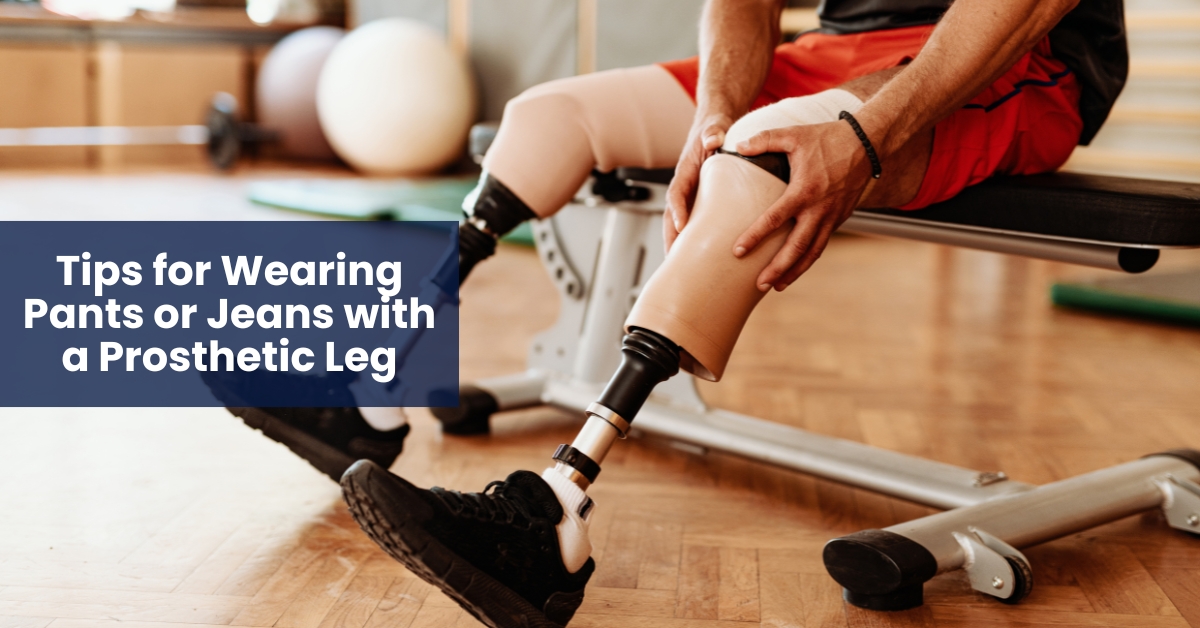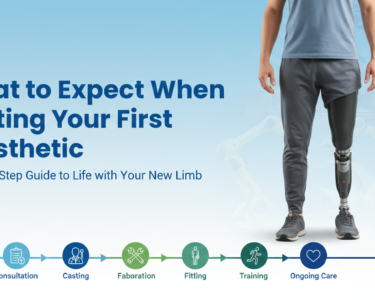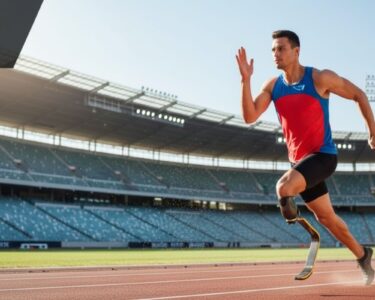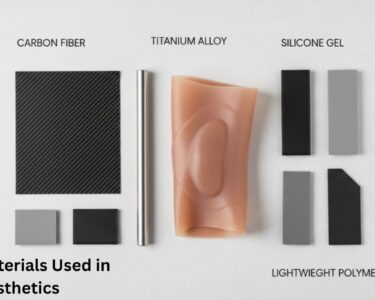Wearing pants or jeans may seem like a simple part of getting dressed each day. However, for individuals with a prosthetic leg, this daily routine can present some unique challenges. From choosing the right fit and material to learning practical dressing techniques, wearing pants over a prosthesis comfortably requires a bit of planning and adaptation. This guide provides a comprehensive look at tips, tricks, and solutions that can help prosthetic users dress more easily, feel more comfortable, and maintain their personal style.
As per research “around 30% of these individuals use a lower-limb prosthesis, making adaptive clothing a significant concern in their daily lives.”
Understanding the Challenges
Wearing pants with a prosthetic leg is different from dressing with natural limbs. Prostheses, especially those with mechanical joints or bulkier sockets, can make pulling pants on and off more difficult.
Tight clothing might snag or bunch around the knee joint or foot, making movement uncomfortable or restricted. Additionally, prosthetic users might deal with skin sensitivity, mobility limitations, or different limb lengths that make clothing fit and function differently than before.
Choose the Right Pants: Style and Fit Matter
1. Straight or Relaxed Fit: Pants with a straight-leg or relaxed fit are easier to wear over a prosthesis. They allow more room for the socket and components of the prosthetic leg, minimizing friction or pressure points.
2. Stretchable Fabrics: Look for materials that include spandex or elastane. Stretchy fabrics conform better to your body and make it easier to pull pants over a prosthetic limb without discomfort.
3. High-Rise or Mid-Rise Waist: These styles offer better coverage and support, especially when sitting or bending, and help the pants stay in place throughout the day.
4. Adaptive Clothing: Consider pants specifically designed for amputees or individuals with limited mobility. These often include features like side zippers, Velcro closures, adjustable hems, or higher backs for seated comfort.
Dressing Techniques That Help
Seated Dressing: Especially useful during the initial rehabilitation period or if you have balance concerns, dressing while seated allows you to control each movement and reduce the risk of falls. It also gives you a better view of how the fabric is lying over your prosthesis.
Standing Dressing with Support: If you prefer standing, use a stable surface like a chair back or wall rail for support. Take your time adjusting the fabric around the socket, knee, and foot areas to ensure comfort and smoothness.
Dress Before or After Wearing Prosthesis? This depends on the type of prosthesis and pants. Loose-fitting pants can be worn after putting on your prosthetic leg, while tight-fitting pants might be easier to slide on before you attach the prosthesis.
Use Liners or Nylon Covers
A simple but effective trick is to wear a nylon sock or smooth fabric liner over your prosthetic leg before dressing. This helps the pants glide smoothly over the surface, preventing them from catching on components like the foot shell or socket. Liners can also help reduce skin irritation and maintain a neat appearance.
Avoid Bulky Seams and Heavy Pockets
When selecting pants or jeans to wear with a prosthetic leg, it’s important to pay attention to the garment’s construction—especially the placement of seams and pockets.
Many fashion-forward designs feature thick outer seams, decorative stitching, or cargo-style side pockets, which may look stylish but can cause discomfort when worn over a prosthesis.
These features can lead to fabric bunching, create unwanted pressure points, or result in skin irritation, especially if the prosthesis comes into frequent contact with those areas.
To ensure a smoother and more comfortable fit, consider choosing pants that have minimal external seams, flat or no side pockets, and soft inner linings. Flat seams, in particular, reduce friction and allow the fabric to glide more naturally over the prosthetic surface.
Lightweight materials with a bit of stretch can also help the pants adapt to the shape of your limb without causing tension or discomfort. By avoiding heavy or bulky design elements, you can enhance both the wearability and the long-term comfort of your clothing.
Think About Hem Length and Footwear
The shape and size of your prosthetic foot might change the way pants fall, especially around the ankle. Keep these tips in mind:
- Longer hems may be needed to cover the prosthetic foot.
- Tailored adjustments can help pants drape evenly.
- Boot-cut or straight-leg styles help balance out the silhouette.
- Choose shoes that are easy to slip on and offer enough space if your prosthetic foot is slightly larger or wider.
Adaptive Clothing Brands and DIY Alterations
In recent years, several clothing brands have launched adaptive lines that cater specifically to individuals who use prosthetic limbs. These garments are thoughtfully designed to offer greater comfort, accessibility, and independence.
When shopping for pants or jeans, look for features such as side leg zippers that make it easier to slip trousers over a prosthetic, especially above-knee types. Expandable waistbands provide a better fit and adjust to any changes in body shape due to prosthetic usage or swelling.
Closures like magnets or Velcro can replace traditional buttons and zippers, making dressing simpler and more manageable, particularly for individuals with limited hand dexterity. Some pants also feature convertible or adjustable hems, allowing wearers to customize the length according to their limb height or footwear.
If you prefer to stick with your existing wardrobe, there are practical DIY options. A professional tailor can modify your jeans or formal trousers by adding invisible zippers, stretch panels, or adjustable cuffs.
These customizations can dramatically improve ease of wear without compromising on style. Such alterations are especially helpful for those who regularly need to remove or adjust their prosthesis throughout the day.
With either adaptive clothing or personalized modifications, prosthetic users can enjoy both function and fashion without compromise.
Several clothing brands now offer adaptive wear designed specifically for prosthetic users. Look for pants with features like side zippers, expandable waistbands, and Velcro closures. If you’re unsure what style suits your limb best, consulting with your prosthetic manufacturer can help ensure a better fit and comfort under clothing.
Laundry Tips: Caring for Your Clothes
Over time, constant wear and movement around a prosthetic limb can cause fabric wear and tear. To maintain comfort and extend the life of your clothes:
- Wash pants in cold water to reduce shrinkage.
- Avoid overly stiff fabrics.
- Air-dry to maintain the shape and stretch of the fabric.
- Use fabric softeners to reduce friction against the prosthesis.
Using Dressing Aids
For those who struggle with flexibility, dressing aids can be very helpful:
- Reachers or grabbers help you pull pants over your foot or prosthesis.
- Dressing sticks assist in positioning waistbands or hems.
- Sock aids can be used to slip liners or covers onto your prosthetic limb smoothly.
These aids promote independence and reduce strain, especially if you’re recovering from surgery or managing multiple mobility challenges.
Safety and Comfort Tips
- Always check for pressure points or signs of skin irritation after wearing new pants.
- Avoid zippers or seams that press directly against the socket.
- In warmer weather, opt for breathable fabrics to avoid sweat buildup.
- In colder months, use thermal liners that also provide a smooth surface under pants.
Final Thoughts
Wearing pants or jeans with a prosthetic leg doesn’t have to be uncomfortable or inconvenient. With a bit of planning, the right clothing, and a few smart tools or techniques, dressing can become a quick, confident part of your day. Each person’s body and prosthetic fit is unique—what works for one user may not work for another. But with experimentation and attention to comfort, you’ll find the styles and methods that suit your lifestyle best.
Your clothes should empower you, not limit you. Choosing the right fit, adapting your routine, and understanding your body’s needs will help you embrace your daily routine with ease and confidence.
Disclaimer:
This content is for informational purposes only and should not replace professional medical advice. Always consult your prosthetist or healthcare provider for personalized recommendations.








